The Best Home Cameras – Everything You Need to Know about Home Cameras
People today tend to care more about home security. That’s why home cameras are increasingly popular, and support more and more advanced features. This is a good thing for sure, since it provides users with more features that facilitate their daily life, and gives them the flexibility to make adjustments according to their needs. Yet on the other hand, people get so confused with all the features and perimeters that choosing a home camera turns out to be a hard task. If you also feel it tricky to choose a proper home camera, read through this article. It will introduce important features of home cameras and how to choose based on your home conditions. Make your investment on home cameras worthwhile.
To start, we should know what types of cameras are available.
Types of Home Camera
Indoor home cameras & outdoor home cameras
Indoor home cameras help monitor what happens inside the house and detect movements when anyone enters a room. Outdoor home cameras installed outside detect motion further away and deter unwanted visitors before they reach the front or back door. With the weatherproof feature, outdoor home cameras perform well even in harsh environments with rain and dust. Indoor and outdoor home cameras working together fully protect you, your family, and your possessions.
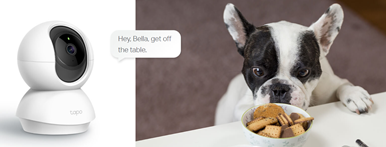
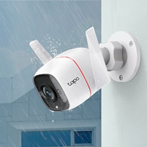
Wireless home cameras & wired home cameras
Wireless home cameras connect to the internet and communicate over Wi-Fi. Wi-Fi home cameras can be powered by AC Power or by batteries. When powered by batteries, wireless home cameras become wire-free home cameras. Wired home cameras connect to a power source and the internet by cable. Wired home cameras use wires to transmit footage.
A primary advantage of wireless security home cameras is that they are much easier to install, adjust and operate than wired cameras. Wireless home cameras often use cloud storage, which allows you to view your footage from anywhere. Wired home cameras tend to be more reliable with consistent video quality and no monthly cloud storage fees.
Then how to choose a home camera? Let’s start with some important features a home camera better supports.
Important Features
[Feature 1: Video Resolution]
Resolution determines the video's quality and how clear and realistic it can be. You may have seen different resolutions on advertisements, such as 720p, 1080p, 2K. Then how different are these resolutions?
|
Resolution |
Image Size |
Image Rendering |
|
720p |
1280×720 |
Identifiable to the eyes; The lowest standard of HD (high definition). |
|
1080p |
1920×1080 |
Clear enough for most electronic devices. The lowest standard of Full HD. |
|
2K |
2048×1080 |
Provides 2 times clearer images than 720p |
|
3MP |
2048×1536 |
A little clearer than 2K |
|
4K |
3840×2160 |
Ultra HD. Provides images with the tiniest details. |
Higher resolution does render clearer images. The higher resolution, the better? Not always. Higher resolution requires more network bandwidth and storage space. Thus, when choosing a home camera, check its highest resolution. Higher resolution is certainly important. Also remember to check the resolution levels it offers. Then, you have the flexibility to change resolution according to real conditions.
[Feature 2: Local Storage / Cloud Storage]
Generally, there are two ways of storage: local storage or cloud storage. To record videos locally, you need to insert a local storage device, usually an SD card. You can easily get access to the local through a computer. A storage device can only hold so much data, so you need to manage that. Many home cameras enable loop recording that overwrites the oldest videos when space is not enough.
Alternatively, you can subscribe to a cloud plan to save recorded videos in the cloud. You can choose different plans that include different number of home cameras or different levels of cloud service. At the same time, companies often charge for this service, with variations based on the number of devices and the amount of storage. Check for free trials wherever possible.
Tapo home cameras mostly support both cloud and local storage, which gives you maximum flexibility.
[Feature 3: Smart Detection]
Home cameras' smart detection function usually consumes less data than traditional home cameras. The home camera will only record the specified detected event. It saves space by not registering irrelevant content while making it easier to find specific video clips.
Camera systems can now do more than detect movement. Detection is becoming more intelligent and specialized to meet users' different needs.
Motion Detection
When your home camera detects motion, it will send you notifications or even sound an alarm. You can personalize your experience by only setting motion zones that capture what happens in the area you select and adjust motion sensitivity.
Most Pan/Tilt home cameras support Motion Tracking. It allows the camera to track motion so you can even follow your pet's activities when you're at work.
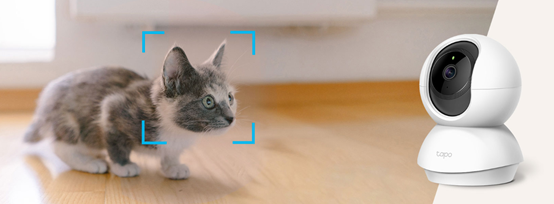
AI Smart Detection
The home camera can detect events and send notifications based on intelligent algorithms that understand people's movements, a baby crying, the actions of your pet, or other subjects. You can easily filter out the specific video clips you care about.
- Person Detection
- Baby Crying Detection
- Pet Detection
- Vehicle Detection
- Package Detection
- Gesture Detection
- Abnormal Sound Detection
- …
Note: Tapo will soon release home cameras with mighty AI smart detections. Stay tuned!
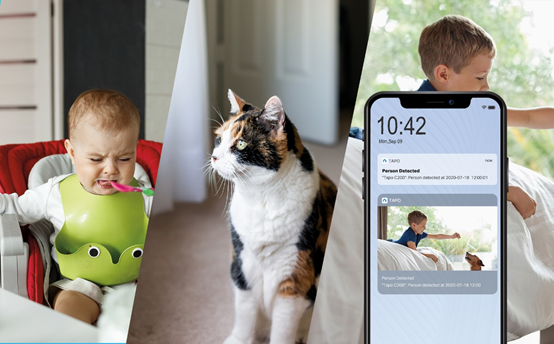
Line-Crossing Detection
Draw one or more virtual lines that should not be crossed in the software. Then if the line is crossed, the home camera will send you notifications or sound an alarm.
For example, if you want to know when someone enters your driveway, you can draw a line on the driveway via the app.
You can also set the crossing direction and detection schedule. It is ideal for fences, property monitoring, and parking areas.

Area Intrusion Detection
Set one or more activity zones. When your home camera detects someone entering the zone, the camera will let you know, and you could have an alarm go off.
For example, add an activity zone at your front door to find out when a delivery person is at your front door or when your kids get home.
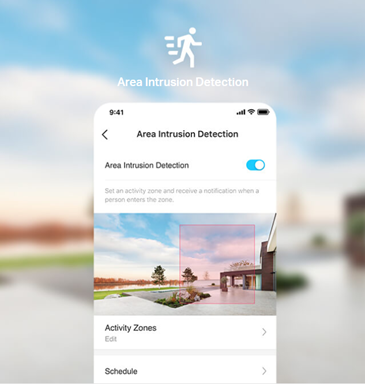
Home Camera Tampering Detection / Cover Detection
When someone tries to knock the home camera down or block the home camera view, the camera will send you notifications or even sound an alarm. It is helpful in locations where the home camera may be physically attacked or where the home camera may be blocked.
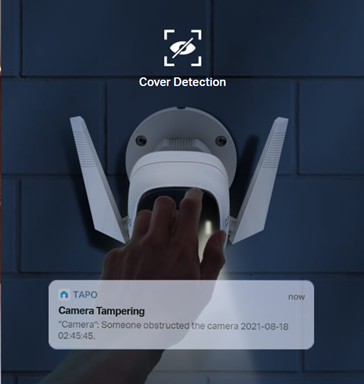
[Feature 4: Black-and-White Night Vision / Full-Color Night Vision / Starlight Vision]
At night, it can be a challenge to spot things.
Most home cameras support infrared (IR) night vision, which creates black-and-white images. The infrared light helps present things unidentifiable to the eyes. IR night vision usually has longer night vision distance, which gives you a wide view of the around. The IR light is also hard to notice. If you don’t want stealers to notice your home camera, then IR night vision is right for you. Yet IR night vision only creates black-and-white images, and thus cannot present more image details.
Full-color night vision, however, provides colorful images at night. Even in low light conditions, home cameras with color night vision will supplement light to capture the images. You will see things more truly in vivid details. It’s more visible, which will work as a deterrent to burglars. But color night vision does not enable you to see as far as IR night vision.
You can have both, actually. Generally, home cameras with full color night vision will also give you the flexibility to choose between the full color or IR night vision, or a smarter mode, i.e., typically running in IR night vision and switching to full color night vision when motion is detected to provide more details.
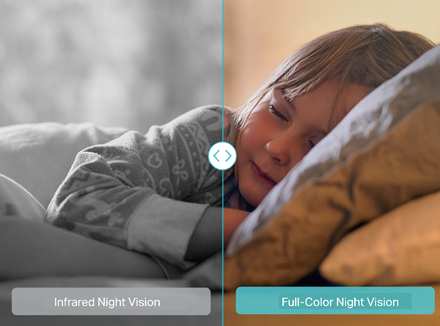
Then what is Starlight Vision? As its name suggests, with just a little starlight, the home camera will create colorful images. It’s usually realized with a starlight sensor. The highly sensitive starlight sensor captures colorful videos even in low-light environments. Compared to home cameras without starlight sensor, home cameras with a built-in starlight sensor have better night video quality. Combined with full-color night vision, night vision will ensure colorful and crystal-clear images.
[Feature 5: Home cameras and Amazon Alexa & Google Home]
Home cameras that work with Amazon Alexa and Google Home make life easier and more convenient, home smarter and more secure. Most home cameras are compatible with Amazon Alexa and Google Home. You can stream home cameras’ live feed on assistant systems-embedded TVs and avoid potential risks in time.
[Feature 6: Privacy Protection]
Home cameras are installed for home security, but you may worry about privacy security under some circumstances. Some home cameras support Privacy Mode helps that keep your private time off the record without unplugging home cameras. Some cameras’ lens can be physically hidden to protect privacy.
Home Camera Recommendations
It's essential to monitor your home for safety when away from home. It is also helpful to watch pets or children when we have to leave the room they are in temporarily.
Tapo's smart WiFi surveillance home cameras have many features:
- Advanced Night Vision – High-definition shooting even at night
- Safe Storage - Video storage on MicroSD Card up to 256GB (the Tapo Care Cloud subscription service is available now)
- Live View – View and share movies saved through the app in real-time
- Sound and Motion Detection – Notifies you in real-time when the home camera detects movement
- Sound and Light Alarm – Trigger light and sound effects to frighten away unwanted visitors
- Two-way Audio - Communicate with a loved one near the home camera.
- Voice Control – Free up your hands with voice control (when associated with a smart speaker)
The Tapo smart home series offers various models with Full HD and HD resolutions. Among indoor home cameras, the Tapo C110 has a fixed frame, and the Tapo C210 features a pan/tilt motion, allowing you to rotate the camera horizontally and vertically. For outdoor home cameras, we have the Tapo C320WS, which has a high-sensitive starlight sensor that captures higher-quality images even in low-light conditions.
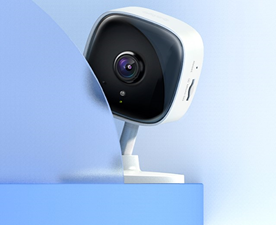
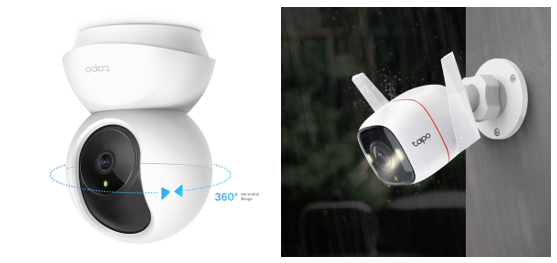
Installation is super easy. Just connect the Tapo smart home camera to the power outlet and home WiFi. You can monitor your smart home directly from your smartphone through the Tapo app, no matter where you are. You can also control it using voice commands by pairing it with a smart speaker.